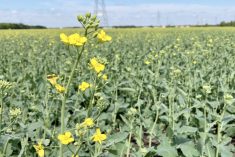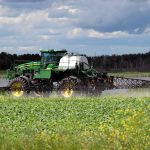Call it a lot of bad news contrasting against the potential for some upside.
Yes, early July — particularly in the southwest corner of Ontario — was not only wet, it was very wet — a deluge that has damaged some crops and probably lowered yield. But the bright spot to this wet first half of the month is that there’s still a sizeable portion of the growing season, and that means there’s still an opportunity for crops to rebound.
Some media reports during the early stages of the week of July 8 stated that farmers were facing losses into the millions of dollars, mostly due to excessive rains. According to Dale Cowan, senior agronomist with Southern Co-operative Services, based in Chatham, there’s been a little too much generalization with media reports. Yes, there has been an inordinate amount of precipitation across the region, but much of it is highly localized.
Read Also

Dryness poised to threaten Saskatchewan crops
Crops in Saskatchewan are developing in opposite directions, the province’s latest crop report said. Growing conditions in the province vary, with some areas receiving enough rain while other locations are experiencing crop stress due to hot, dry conditions.
“The corridor between Chatham and Wallaceburg and over into the Tupperville area just can’t get a break,” says Cowan, noting that some farms, dating back to June 26, had received 14 inches of rain in 14 days. “They’re averaging an inch a day, but it didn’t come every day, it came in about four events and they were pretty intense. So there’s a lot of water damage, but then if you get a little further south and little further east, we’ve had our fair share of rain, but we haven’t had it as badly as that corridor.”
Tomatoes and sugar beets are struggling, adds Cowan, with spotty reports of sugar beets rotting in the fields. Compounding the problem is the stage of the growing season. For any crop — sugar beets, tomatoes, or corn and soybeans, it’s too late for replanting.
According to figures from Weather INnovations Consulting in Chatham, the period of July 4-10 saw eight communities reporting 100 mm or more of precipitation, including the Toronto flood on July 8. Jeanette’s Creek, just east of Tilbury, recorded 159 mm of rain during that seven-day period. Harrow picked up 140 mm and Guelph saw 107.8. In terms of single-day events, Mitchell’s Bay on Lake St. Clair, recorded 76 mm on July 5, Harrow received 49 mm the following day, Guelph picked up 55 mm on July 7 and Toronto had the largest amount of rain in one day, with 126 mm recorded on July 8.
“The trouble right now is that it’s ideal weather for fungus, so trying to get a fungicide down — and we can’t do it with ground rigs, so getting enough aerial applicators in — is a concern,” says Cowan.
While it’s obvious that there’s been crop loss from standing water, the extent is yet to be known, says Cowan
The corn crop in parts of extreme southwestern Ontario is beginning to suffer, and has lost significant amounts of nitrogen. Corn yields are likely to lose some off the top, and although soybeans are likely to see an increased level of root rot, Cowan reminds growers that soybeans make their yield during late summer.
Further east and north, July 10 saw significant damage to crops in the Hensall district, as well as in Oxford County communities such as Embro. Corn and soybean fields in and around Hensall were reported as “stripped” by a sudden and powerful hail storm. Portions of corn fields north of Embro looked to have been flattened by high winds.
On a positive note, however, Cowan states that the wheat crop in Essex and west Kent looked to be in good shape in the early part of the month. In fact, the harvest is now underway in many parts of southern Ontario, including areas as far north as Palmerston and Mildmay.



















